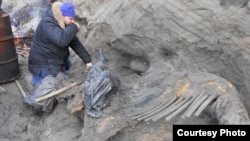A Siberian mammoth carcass displays some tantalizing hints that man was present in the Eurasian Arctic 10,000 years earlier than thought.
The male woolly mammoth carcass was found in 2012 near Yenisei Bay in the Siberian Arctic.
Through radiocarbon dating of the animal's tibia bone and surrounding materials, the researchers dated it at 45,000 years old.
The carcass appears to have some unusual injuries on its ribs, tusk and jaw. These, researchers believe, could have been inflicted by the spears of human hunters some 10,000 years before man has been thought to have arrived in the Arctic.
“One can almost see the blow-by-blow battle between people and mammoth fought on those frozen plains,” Curtis Marean, a paleoanthropologist at Arizona State University who was not involved with the study, told Science Magazine. “The impact wounds on the bones with embedded stone fragments is conclusive evidence that people slayed this mammoth.”
Mammoths provided an excellent source of food, and hunting them likely allowed humans to “spread widely,” even in the northernmost part of Arctic Siberia. It’s possible that this helped early man cross the Bering land bridge into the New World, during the last ice age.
"Indeed, these animals provide an endless source of different goods: food with meat, fat and marrow; fuel with dung, fat and bones; and raw material with long bones and ivory," lead author Vladimir Pitulko of the Russian Academy of Sciences told Reuters. "They certainly would use them as food, especially certain parts like tongue or liver as a delicacy, but hunting for the ivory was more important."
The paper was published Thursday in the journal Science.









